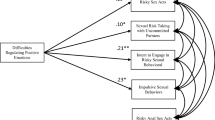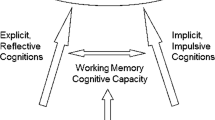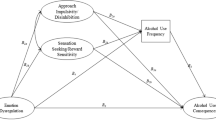Abstract
This study evaluated dual process interaction models of HIV-risk behavior among drug offenders. A dual process approach suggests that decisions to engage in appetitive behaviors result from a dynamic interplay between a relatively automatic associative system and an executive control system. One synergistic type of interplay suggests that executive functions may dampen or block effects of spontaneously activated associations. Consistent with this model, latent variable interaction analyses revealed that drug offenders scoring higher in affective decision making were relatively protected from predictive effects of spontaneous sex associations promoting risky sex. Among drug offenders with lower levels of affective decision making ability, spontaneous sexually-related associations more strongly predicted risky sex (lack of condom use and greater number of sex partners). These findings help elucidate associative and control process effects on appetitive behaviors and are important for explaining why some individuals engage in risky sex, while others are relatively protected.





Similar content being viewed by others
References
Kahneman D. A perspective on judgment and choice: mapping bounded rationality. Am Psychol. 2003;58(9):697–720.
Jacoby LL, Rhodes MG. False remembering in the aged. Curr Dir Psychol Sci. 2006;15(2):49–53.
Stacy AW, Ames SL, Knowlton BJ. Neurologically plausible distinctions in cognition relevant to drug use etiology and prevention. Subst Use Misuse. 2004;39(10–12):1571–623.
Wiers RW, Ames SL, Hoffmann W, Krank M, Stacy AW. Impulsivity, impulsive and reflective processes and the development of alcohol use and misuse in adolescents and young adults. Front Psychopathol. 2010;1:1–12.
Bechara A, Noel X, Crone EA. Loss of willpower: Abnormal neural mechanisms of impulse control and decision-making in addiction. In: Wiers RW, Stacy AW, editors. Handbook of implicit cognition and addiction. Thousand Oaks: Sage; 2006. p. 215–32.
Deutsch R, Strack F. Reflective and impulsive determinants of addictive behavior. In: Wiers RW, Stacy AW, editors. Handbook of implicit cognition and addiction. Thousand Oaks: Sage; 2006. p. 45–57.
Evans JSBT, Coventry K. A dual process approach to behavioral addiction: the case of gambling. In: Wiers RW, Stacy AW, editors. Handbook of implicit cognition and addiction. Thousand Oaks: Sage; 2006. p. 29–44.
Wiers RW, Bartholow BD, van den Wildenberg E, Thush C, Engels RC, Sher KJ, et al. Automatic and controlled processes and the development of addictive behaviors in adolescents: a review and a model. Pharmacol Biochem Behav. 2007;86(2):263–83.
Stacy AW, Wiers RW. Implicit cognition and addiction: a tool for explaining paradoxical behaviors. Annu Rev Clin Psychol. 2010;6:551–75.
Wiers RW, Stacy AW. Implicit cognition and addiction. Curr Dir Psychol Sci. 2006;15(6):292–6.
Wiers RW, Stacy AW. Handbook of implicit cognition and addiction. Thousand Oaks: Sage; 2006.
Ames SL, Franken IHA, Coronges K. Implicit cognition and drugs of abuse. In: Wiers RW, Stacy AW, editors. Handbook of implicit cognition and addiction. Thousand Oaks: Sage; 2006. p. 363–78.
McCusker CG. Cognitive biases and addiction: an evolution in theory and method. Addiction. 2001;96(1):47–56.
Rooke SE, Hine DW, Thorsteinsson EB. Implicit cognition and substance use: a meta-analysis. Addict Behav. 2008;33(10):1314–28.
Czopp AM, Monteith MJ, Zimmerman RS, Lynam DR. Implicit attitudes as potential protection from risky sex: predicting condom use with the IAT. Basic Appl Soc Psychol. 2004;26(2–3):227–36.
Marsh KL, Johnson BT, Scott-Sheldon LA. Heart versus reason in condom use: implicit versus explicit attitudinal predictors of sexual behavior. Z Exp Psychol. 2001;48(2):161–75.
Geer JH, Robertson GG. Implicit attitudes in sexuality: gender differences. Arch Sex Behav. 2005;34(6):671–7.
Gillath O, Mikulincer M, Birnbaum GE, Shaver PR. Does subliminal exposure to sexual stimuli have the same effects on men and women? J Sex Res. 2007;44(2):111–21.
Ponseti J, Bosinski HAG. Subliminal sexual stimuli facilitate genital response in women. Arch Sex Behav. 2010;39(5):1073–9.
Snowden RJ, Wichter J, Gray NS. Implicit and explicit measurements of sexual preference in gay and heterosexual men: a comparison of priming techniques and the Implicit Association Task. Arch Sex Behav. 2008;37(4):558–65.
Penke L, Eichstaedt J, Asendorpf JB. Single-Attribute Implicit Association Tests (SA-IAT) for the assessment of unipolar constructs: the case of sociosexuality. Exp Psychol. 2006;53(4):283–91.
Stacy AW, Newcomb MD, Ames SL. Implicit cognition and HIV risk behavior. J Behav Med. 2000;23(5):475–99.
Stacy AW, Ames SL, Ullman JB, Zogg JB, Leigh BC. Spontaneous cognition and HIV risk behavior. Psychol Addict Behav. 2006;20(2):196–206.
Ames SL, Andsager JL, Houska B, Leigh BC, Stacy AW. Content analysis of drug offenders’ sketches on the draw-an-event test for risky sexual situations. Am J Health Behav. 2005;29(5):407–12.
Ames SL, Zogg JB, Stacy AW. Implicit cognition, sensation seeking, marijuana use and driving behavior among drug offenders. Pers Individ Differ. 2002;33(7):1055–72.
Gray NS, Brown AS, MacCulloch MJ, Smith J, Snowden RJ. An implicit test of the associations between children and sex in pedophiles. J Abnorm Psychol. 2005;114(2):304–8.
Stacy AW. Memory association and ambiguous cues in models of alcohol and marijuana use. Exp Clin Psychopharmacol. 1995;3(2):183–94.
Stacy AW. Memory activation and expectancy as prospective predictors of alcohol and marijuana use. J Abnorm Psychol. 1997;106(1):61–73.
Smith ER, DeCoster J. Dual-process models in social and cognitive psychology: conceptual integration and links to underlying memory systems. Pers Soc Psychol Rev. 2000;4(2):108–31.
Strack F, Deutsch R. Reflective and impulsive determinants of social behavior. Pers Soc Psychol Rev. 2004;8(3):220–47.
Gawronski B, Bodenhausen GV. Associative and propositional processes in evaluation: an integrative review of implicit and explicit attitude change. Psychol Bull. 2006;132(5):692–731.
Gould TJ. Addiction and cognition. Addict Sci Clin Pract. 2010;5:4–14.
Yin HH, Knowlton BJ. Addiction and learning in the brain. In: Wiers RW, Stacy AW, editors. Handbook of implicit cognition and addiction. Thousand Oaks: Sage; 2006. p. 167–84.
Bechara A, Van der Linden M. Decision-making and impulse control after frontal lobe injuries. Curr Opin Neurol. 2005;18:734–9.
Lawrence NS, Jollant F, O’Daly O, Zelaya F, Phillips ML. Distinct roles of prefrontal cortical subregions in the Iowa Gambling Task. Cereb Cortex. 2009;19(5):1134–43.
Bechara A, Damasio AR, Damasio H, Anderson SW. Insensitivity to future consequences following damage to human prefrontal cortex. Cognition. 1994;50(1–3):7–15.
Dunn BD, Dalgleish T, Lawrence AD. The somatic marker hypothesis: a critical evaluation. Neurosci Biobehav Rev. 2006;30(2):239.
Bechara A, Damasio H. Decision-making and addiction (Part I): impaired activation of somatic states in substance dependent individuals when pondering decisions with negative future consequences. Neuropsychologia. 2002;40(10):1675–89.
Bechara A, Dolan S, Hindes A. Decision-making and addiction (Part II): Myopia for the future or hypersensitivity to reward? Neuropsychologia. 2002;40(10):1690–705.
Brand M, Labudda K, Markowitsch HJ. Neuropsychological correlates of decision-making in ambiguous and risky situations. Neural Networks. 2006;19(8):1266–76.
Wardle MC, Gonzalez R, Bechara A, Martin-Thormeyer E. Iowa Gambling Task performance and emotional distress interact to predict risky sexual behavior in individuals with dual substance and HIV diagnoses. J Clin Exp Neuropsychol. 2010;32(10):1110–21.
Avants SK, Margolin A, McMahon TJ, Kosten TR. Association between self-report of cognitive impairment, HIV status, and cocaine use in a sample of cocaine-dependent methadone-maintained patients. Addict Behav. 1997;22(5):599–611.
Anand P, Springer SA, Copenhaver MM, Altice FL. Neurocognitive impairment and HIV risk factors: a reciprocal relationship. AIDS Behav. 2010;14(6):1213–26.
Copenhaver M, Avants SK, Warburton LA, Margolin A. Intervening effectively with drug abusers infected with HIV: taking into account the potential for cognitive impairment. J Psychoactive Drugs. 2003;35(2):209–18.
Kalichman SC. Co-occurrence of treatment nonadherence and continued HIV transmission risk behaviors: implications for positive prevention interventions. Psychosom Med. 2008;70(5):593–7.
Kalichman SC, Benotsch E, Suarez T, Catz S, Miller J, Rompa D. Health literacy and health-related knowledge among persons living with HIV/AIDS. Am J Prev Med. 2000;18(4):325–31.
Payne BK. Conceptualizing control in social cognition: how executive functioning modulates the expression of automatic stereotyping. J Pers Soc Psychol. 2005;89(4):488–503.
Hofmann W, Rauch W, Gawronski B. And deplete us not into temptation: automatic attitudes, dietary restraint, and self-regulatory resources as determinants of eating behavior. J Exp Soc Psychol. 2007;43(3):497–504.
De Neys W. Dual processing in reasoning: two systems but one reasoner. Psychol Sci. 2006;17(5):428–33.
Finn PR, Hall J. Cognitive ability and risk for alcoholism: short-term memory capacity and intelligence moderate personality risk for alcohol problems. J Abnorm Psychol. 2004;113(4):569–81.
Thush C, Wiers RW, Ames SL, Grenard JL, Sussman S, Stacy AW. Interactions between implicit and explicit cognition and working memory capacity in the prediction of alcohol use in at-risk adolescents. Drug Alcohol Depend. 2008;94(1–3):116–24.
Grenard JL, Ames SL, Wiers RW, Thush C, Sussman S, Stacy AW. Working memory capacity moderates the predictive effects of drug-related associations on substance use. Psychol Addict Behav. 2008;22(3):426–32.
Houben K, Wiers RW. Response inhibition moderates the relationship between implicit associations and drinking behavior. Alcohol Clin Exp Res. 2009;33(4):626–33.
Leigh BC, Ames SL, Stacy AW. Alcohol, drugs, and condom use among drug offenders: an event-based analysis. Drug Alcohol Depend. 2008;93(1–2):38–42.
Hays RD, Gillogly JJ, Hill L, Lewis MW, Bell RM, Nicholas R. A Microcomputer Assessment System (MAS) for administering computer-based surveys: preliminary results from administration to clients at an impaired-driver treatment program. Behav Res Methods Instr Comput. 1992;24:358–65.
Lewis MW, Merz J, Hays RD, Nicholas R. Perceptions of intoxication and impairment at arrest among adults convicted of driving under the influence of alcohol. J Drug Iss. 1995;25:141–60.
Marshall GN, Hays RD, Nicholas R. Evaluating agreement between clinical assessment methods. Int J Methods Psychiatr Res. 1994;4:249–57.
Ames SL, Grenard JL, Thush C, Sussman S, Wiers RW, Stacy AW. Comparison of indirect assessments of association as predictors of marijuana use among at-risk adolescents. Exp Clin Psychopharmacol. 2007;15(2):204–18.
Wiers RW, Gunning WB, Sergeant JA. Is a mild deficit in executive functions in boys related to childhood ADHD or to parental multigenerational alcoholism? J Abnorm Child Psychol. 1998;26(6):415–30.
Wiers RW, van Woerden N, Smulders FTY, de Jong PJ. Implicit and explicit alcohol-related cognitions in heavy and light drinkers. J Abnorm Psychol. 2002;111(4):648–58.
Weingardt KR, Stacy AW, Leigh BC. Automatic activation of alcohol concepts in response to positive outcomes of alcohol use. Alcohol Clin Exp Res. 1996;20(1):25–30.
Levy DA, Stark CEL, Squire LR. Intact conceptual priming in the absence of declarative memory. Psychol Sci. 2004;15(10):680–6.
Seger CA, Rabin LA, Desmond JE, Gabrieli JDE. Verb generation priming involves conceptual implicit memory. Brain Cogn. 1999;41(2):150–77.
Vaidya CJ, Gabrieli JDE, Keane MM, Monti LA. Perceptual and conceptual memory processes in global amnesia. Neuropsychology. 1995;9(4):12.
Zeelenberg R, Shiffrin RM, Raaijmakers JGW. Priming in a free association task as a function of association directionality. Mem Cogn. 1999;27(6):956.
Hutchison KA. Is semantic priming due to association strength or feature overlap? A microanalytic review. Psychon Bull Rev. 2003;10(4):785–813.
Nelson DL, McKinney VM, Gee NR, Janczura GA. Interpreting the influence of implicitly activated memories on recall and recognition. Psychol Rev. 1998;105:299–324.
Roediger HL, Watson JM, McDermott KB, Gallo DA. Factors that determine false recall: a multiple regression analysis. Psychon Bull Rev. 2001;8(3):385–407.
Stacy AW, Ames SL, Grenard J. Word association tests of associative memory and implicit processes: theoretical and assessment issues. In: Wiers RW, Stacy AW, editors. Handbook of implicit cognition and addiction. Thousand Oaks: Sage; 2006. p. 75–90.
Semantic retrieval versus selection in verb generation: an fMRI investigation. In: 47th annual meeting of the psychonomic society; November 2006.
Chein JM, Schneider W. Neuroimaging studies of practice-related change: fMRI and meta analytic evidence of a domain-general control network for learning. Cogn Brain Res. 2005;25:607–23.
Schneider W, Chein JM. Controlled & automatic processing: behavior, theory, and biological mechanisms. Cogn Sci. 2003;27:525–59.
Stacy AW, Wiers RW. An implicit cognition, associative memory framework for addiction. In: Munafo MR, Albery IP, editors. Cognition and addiction. New York: Oxford University Press; 2006. p. 31–71.
Ruff RM, Light RH, Parker SB, Levin HS. Benton controlled oral word association test: reliability and updated norms. Arch Clin Neuropsychol. 1996;11(4):329–38.
Szalay LB, Windle C, Lysne DA. Attitude measurement by free verbal associations. J Soc Psychol. 1970;82(1):43–55.
Stacy AW, Galaif ER, Sussman S, Dent CW. Self-generated drug outcomes in high-risk adolescents. Psychol Addict Behav. 1996;10(1):18–27.
Sussman S, Ames SL, Dent CW, Stacy AW. Self-reported high-risk locations of drug use among drug offenders: ethnic and gender differences. Hispanic J Behav Sci. 2000;22(2):237–53.
Zogg JB, Ma H, Dent CW, Stacy AW. Self-generated alcohol outcomes in 8th and 10th graders: exposure to vicarious sources of alcohol information. Addict Behav. 2004;29:3–16.
Bechara A, Damasio H, Tranel D, Anderson SW. Dissociation of working memory from decision making within the human prefrontal cortex. J Neurosci. 1998;18(1):428–37.
Bechara A, Tranel D, Damasio H. Characterization of the decision-making deficit of patients with ventromedial prefrontal cortex lesions. Brain. 2000;123(11):2189–202.
Graham JW, Flay BR, Johnson CA, Hansen WB, Grossman L, Sobel J. Reliability of self-report measures of drug use in prevention research: evaluation of the project SMART questionnaire via the test–retest reliability matrix. J Drug Educ. 1984;14(2):175–93.
Ames SL, Stacy AW. Implicit cognition in the prediction of substance use among drug offenders. Psychol Addict Behav. 1998;12(4):272–81.
Darke S. Self-report among injecting drug users: a review. Drug Alcohol Depend. 1998;51(3):253–63.
Marsh HW, Wen Z, Hau KT. Structural equation models of latent interactions: evaluation of alternative estimation strategies and indicator construction. Psychol Methods. 2004;9(3):275–300.
Marsh HW, Wen Z, Hau K, Little TD, Bovaird JA, Widaman KF. Unconstrained structural equation models of latent interactions: contrasting residual-and mean-centered approaches. Struct Equ Model. 2007;14(4):570–80.
Little TD, Bovaird JA, Widaman KF. On the merits of orthogonalizing powered and product terms: implications for modeling interactions among latent variables. Struct Equ Model. 2006;13:497–519.
Muthén LK, Muthén BO. Mplus: statistical analysis with latent variables: user’s guide. 4th ed. Los Angeles: Muthén & Muthén; 2006.
Marsh HW, Hau K, Grayson D. Goodness of fit in structural equation models. In: Maydeu-Olivares A, McArdle JJ, editors. Contemporary psychometrics: a festschrift for Roderick P. McDonald. Multivariate applications book series. Mahwah: Lawrence Erlbaum Associates Publishers; 2005. p. 275–340.
MacCallum RC, Browne MW, Sugawara HM. Power analysis and determination of sample size for covariance structure modeling. Psychol Methods. 1996;1(2):130–49.
Little T, Cunningham W, Shahar G, Widaman K. To parcel or not to parcel: exploring the question, weighing the merits. Struct Equ Model. 2002;9(2):151–73.
Mokken RJ, Lewis C. A nonparameteric approach to the analysis of dichotomous item responses. Appl Psychol Meas. 1982;6(4):417–30.
Hu L, Bentler PM. Cutoff criteria for fit indexes in covariance structure analysis: conventional criteria versus new alternatives. Struct Equ Model. 1999;6:1–55.
Thush C, Wiers RW, Ames SL, Grenard JL, Sussman S, Stacy AW. Apples and oranges? Comparing indirect measures of alcohol-related cognition predicting alcohol use in at-risk adolescents. Psychol Addict Behav. 2007;21(4):587–91.
Avants SK, Warburton LA, Hawkins KA, Margolin A. Continuation of high-risk behavior by HIV-positive drug users. Treatment implications. J Subst Abuse Treat. 2000;19(1):15–22.
Fiore MC, Bailey WC, Cohen SJ, Dorfman SF, Goldstein MG, Gritz ER. Treating tobacco use and dependence: clinical practice guideline. Rockville: U.S. Department of Health and Human Services, Public Health Service; 2000.
Sussman S, Earleywine M, Wills T, Cody C, Biglan T, Dent CW, et al. The motivation, skills, and decision-making model of “drug abuse” prevention. Subst Use Misuse. 2004;39(10):1971–2016.
Acknowledgments
This research was supported by grants from the National Institute on Drug Abuse (DA023368, DA024659, DA024772) and the National Institute on Alcohol Abuse and Alcoholism (AA017996).
Author information
Authors and Affiliations
Corresponding author
Rights and permissions
About this article
Cite this article
Ames, S.L., Grenard, J.L. & Stacy, A.W. Dual Process Interaction Model of HIV-Risk Behaviors Among Drug Offenders. AIDS Behav 17, 914–925 (2013). https://doi.org/10.1007/s10461-012-0140-2
Published:
Issue Date:
DOI: https://doi.org/10.1007/s10461-012-0140-2




